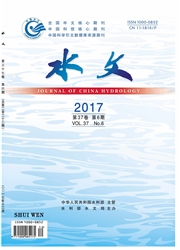

 中文摘要:
中文摘要:
基于珠江流域内43个常规气象站点1960-2012年的逐日降水资料,计算了流域内各站点长期降水集中度(LCI)和逐年降水集中度(ACI);采用Mann-Kendall趋势检验法和Sen’s坡度检验法检测ACI时间上的变化趋势;同时采用反距离权重插值法(IDW)对LCI的区域特征和ACI的变化趋势进行空间插值以分析降水集中度的时空分布规律;采用随机森林(RF)算法对降水集中度的影响因子进行重要度分析。结果表明:(1)珠江流域逐年降水集中度ACI的年际变化不明显,东南部呈上升趋势,西北部呈下降趋势;(2)珠江流域西北部长期降水集中度LCI值偏小,即降水分布较平均;东南部长期降水集中度LCI值偏大,即降水较集中,表明该地区降水极值情况发生的几率相对较高,该空间分布趋势可能是受距离海洋的远近及海拔的影响;(3)众多气候影响因子中,东亚夏季季风(EASMI)对珠江流域的降水集中度影响最明显。
 英文摘要:
英文摘要:
Under the influence of the well-evidenced global warming, extreme precipitation events are likely to occur more and more frequently. As a result, the urban flood control and waterlogging prevention are under serious threat. The extreme precipitation events can be effectively identified by precipitation concentration index (CI), which is mainly used to describe the inhomogeneity of precipitation. This paper attempts to explore the spatiotemporal variations and the causes of precipitation concentration. Mann-Kendall statistical test and Sen ' s slope method were used to detect the temporal patterns of A CI (annual precipitation concentration index), and inverse distance weighted (IDW) interpolation method was used to analyze the spatial change of LCI (long period precipitation concentration index) as well as the temporal variation trend of A CI based on daily precipitation at the 43 stations during 1960-2012 in the Pearl River Basin. Meanwhile, the random forest algorithm (RF) was applied to identify the contributions of the influencing factors. The results show that: (1) The northwest ofPearl River Basin indicates lower LCI while the southeast part indicates higher LCI, which shows that the extreme precipitation events will occur more frequently in the southeast. (2) The interannual variation of ACI in Pearl RiverBasin is notobvious, the northwestpart shows decreasing trend while the southeast part shows increasing trend, the spatial distribution trend is likely to be affected by distance from ocean and altitude. (3) The importance analysis based on RF shows that the east Asian summer monsoon (EASMI) is the most significant factor of precipitation concentration among the 7 factors.
 同期刊论文项目
同期刊论文项目
 同项目期刊论文
同项目期刊论文
 期刊信息
期刊信息
